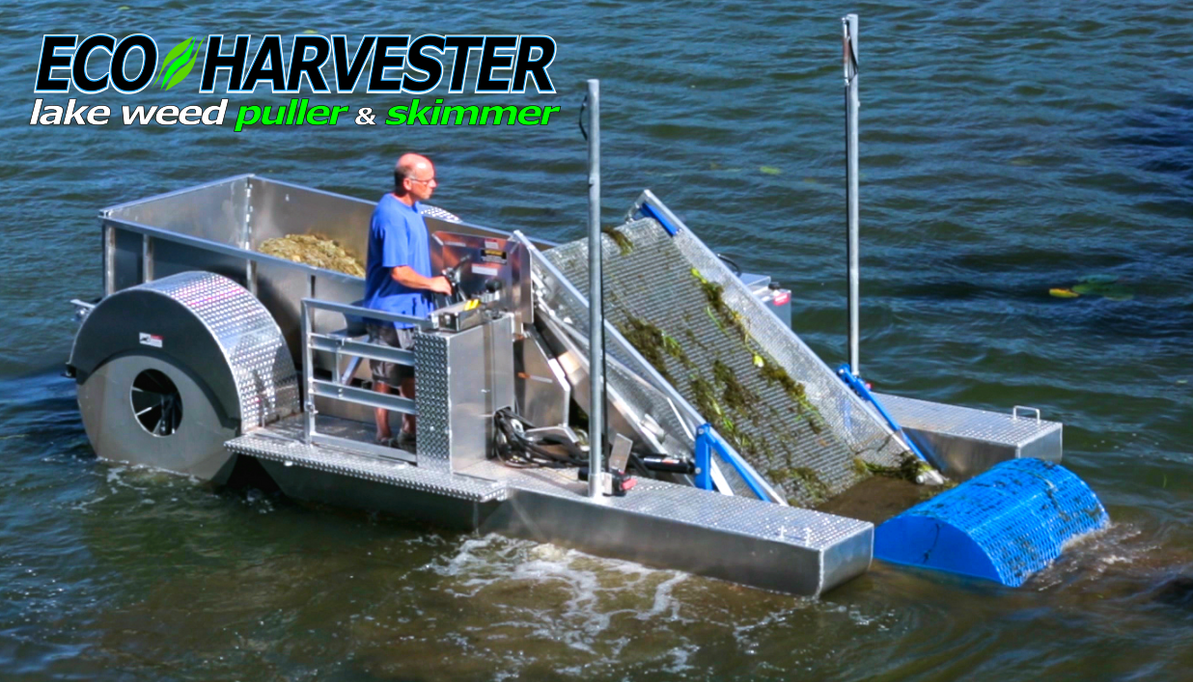Eco-Harvester: The Smart Late-Summer and Early Fall Solution for Large-Scale Weed Removal
When autumn sets in, the green canopy of aquatic weeds begins its final collapse. But those plants don’t just disappear. They sink to the bottom, where they slowly decompose under the ice all winter long. That decaying biomass becomes fuel for spring algae blooms and thick layers of muck which provides the fuel for the following season's weed growth.
For lake associations, municipalities, and businesses responsible for larger lakes, ignoring this late-season die-off often means bigger problems in the spring. The Eco-Harvester changes that. While many think of it as a summer tool, its real value shines in early to late fall, making it an essential part of any year-round management plan.
Why Late-Summer & Early Fall Harvesting Changes the Game
Most aquatic harvesters are designed to cut weeds, leaving roots and plant fragments behind. Those fragments sink, decay, and often regrow the following season. The Eco-Harvester works differently. It doesn’t just cut, it pulls weeds up by the root and collects them in bulk, removing them entirely from the water.
That makes late summer and early fall the ideal time to use it. Instead of clearing a temporary path, you’re eliminating the entire season’s growth in one final push. By preventing biomass from rotting under the ice, you reduce muck buildup and starve next year’s algae blooms before they start. The results aren’t just short-term. A late summer or early fall harvest sets the stage for a cleaner, healthier lake come spring.
For associations, this means cleaner swimming areas and shorelines that members can enjoy, resulting in fewer complaints and stronger community satisfaction. For businesses and recreation properties, it ensures a positive first impression when the season opens, which directly improves guest satisfaction and supports revenue growth.
How Lake Associations Benefit from the Eco-Harvester
Lake associations are the heart of many lake communities, but they’re also a shared responsibility. Associations that invest in the Eco-Harvester demonstrate to members that their dues are going toward long-term improvements. A late-season harvest clears swimming zones, keeps fishing areas accessible, and maintains clean shorelines for families. It’s a proactive approach that prevents frustration, reduces spring cleanup budgets, and builds trust among members.
For campgrounds, resorts, and recreational parks, the Eco-Harvester is equally valuable. A clean, weed-free lake is a key attraction, and nothing hurts a guest’s experience faster than thick weeds or muck. By harvesting in the fall, businesses “winterize” their lakes and open in spring with clear water and inviting shorelines. That kind of early-season wow factor gives properties a competitive edge and protects the investment they’ve made in their waterfronts.
Built for Heavy-Duty Conditions
Fall conditions are tough on equipment. Colder water, thick mats of weeds, and heavy debris can push older or smaller machines past their limits. Breakdowns are common, and repairs at the end of the season are costly.
The Eco-Harvester is built for these conditions. Its durable construction and flexible design allow it to power through late-season challenges without constant maintenance. For large-scale operations, that reliability is critical. It means teams can keep working until freeze-up, finishing the job thoroughly and avoiding the expense of half-done projects or damaged equipment.
The Impact You See by Spring
Organizations that prioritize late summer and early fall harvesting with the Eco-Harvester consistently notice the difference. Water clarity is higher, muck accumulation is lower, and shorelines stay cleaner. Because root systems of invasive species are removed, weed regrowth in the spring is dramatically reduced.
For professional lake managers, late fall isn’t the end of the season, it’s the final opportunity to set the stage for success in spring. The Eco-Harvester is built for this moment. Unlike cutters that leave fragments behind, it removes and collects weeds completely, stopping muck and algae before they start.
Instead of battling thick weeds in April and May, managers stay ahead of the problem. Members, customers, and communities see immediate results, and those results reinforce the value of proactive management.
Recent Posts
-
Lakefront Living Winter: Enjoy Your Property Year-Round
Lake Life in Winter: How to Protect and Enjoy Your Waterfront Year-Round There is a quiet magic to w …7th Jan 2026 -
Choosing the Right Dock De-Icer for Winter Protection
Winter brings its own kind of beauty, but it also brings the challenge of ice around your dock. Ice …24th Dec 2025 -
Ice Fishing Essentials: Gear and Tips for a Successful Season
When winter settles in and the lakes freeze, ice fishing becomes one of the calmest and most rewardi …17th Dec 2025





